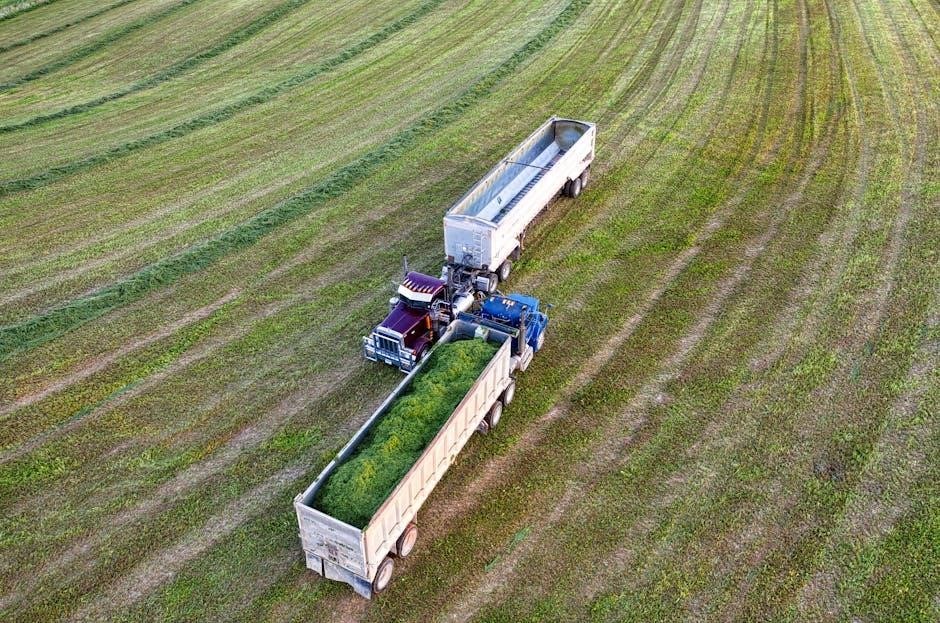Not all semi-trucks are manual; many now feature automatic or hybrid transmissions. This shift towards automation improves fuel efficiency and driver comfort, reflecting industry trends.
Overview of Semi-Trucks and Their Transmission Systems
Semi-trucks, essential for heavy-duty transportation, rely on advanced transmission systems to manage massive torque and payloads. Traditionally, manual transmissions dominated, requiring driver input for gear shifts. However, modern semi-trucks increasingly feature automatic or hybrid systems, such as automated manual transmissions (AMTs), which combine manual gearboxes with computer-controlled shifting. These systems enhance fuel efficiency, reduce driver fatigue, and improve performance. While manual transmissions remain common in certain applications, the industry is shifting toward automation to meet evolving demands for efficiency and driver comfort.
What Are Semi-Trucks?
Semi-trucks, also known as 18-wheelers, are large vehicles designed for heavy-duty hauling. They play a critical role in transporting goods across long distances, supporting global commerce.
Definition and Role in Transportation
Semi-trucks, or 18-wheelers, are large commercial vehicles designed for heavy-duty hauling. They consist of a tractor unit and a trailer, capable of transporting massive loads over long distances. These vehicles are indispensable in global logistics, forming the backbone of freight transportation. They ensure the movement of goods across regions, supporting supply chains and economies worldwide. Their size and capacity enable efficient bulk transport, making them a cornerstone of modern commerce. Semi-trucks are essential for connecting manufacturers, warehouses, and retailers, facilitating the seamless flow of goods and resources.

Manual vs. Automatic Transmissions in Semi-Trucks
Understanding the Basics of Transmission Systems
Manual transmissions require driver input for gear shifting, while automatics use computer-aided systems to shift automatically. This reduces driver fatigue and enhances fuel efficiency in modern trucks.
Transmission systems in semi-trucks are designed to transfer power from the engine to the wheels efficiently. Manual transmissions require drivers to manually shift gears using a clutch, while automatic transmissions use a torque converter and sensors to shift automatically. Modern semi-trucks often feature Automated Manual Transmissions (AMTs), which combine a manual gearbox with computer-controlled shifting. These systems simplify driving, reduce fatigue, and optimize performance. Unlike passenger cars, semi-truck automatics are typically based on manual transmissions with added automation, ensuring heavy-duty capabilities and improved fuel efficiency.

Are All Semi-Trucks Manual?
No, not all semi-trucks are manual. Many modern models now feature automatic or hybrid transmission systems, offering improved fuel efficiency and driver comfort, as industry trends evolve.
Exploring the Prevalence of Manual and Automatic Transmissions
While manual transmissions were once dominant in semi-trucks, the industry has shifted significantly. Today, over 90% of new semi-trucks are equipped with automatic transmissions, reflecting a growing preference for ease of use and fuel efficiency. Big fleets increasingly favor automatics, as they reduce the need for experienced drivers and lower training costs. Manual transmissions, though still present, are being phased out in favor of automated manual transmissions (AMTs), which combine the efficiency of manuals with the convenience of automatics. This shift underscores the evolving needs of modern trucking operations.

Manual Transmissions in Semi-Trucks
Manual transmissions have historically dominated semi-trucks due to their durability and control, especially for heavy loads. They require skilled drivers but are being phased out gradually.
Why Manual Transmissions Have Historically Been the Norm
Manual transmissions have long been the standard in semi-trucks due to their reliability, durability, and ability to handle heavy loads and high torque. Traditionally, manual gearboxes provided better control for drivers, especially in challenging conditions like steep inclines or varying terrains. They also required less complex technology, making them more cost-effective and easier to maintain. Additionally, manual transmissions allowed drivers to have more direct control over shifting, which was crucial for managing large vehicles. This made them the preferred choice for fleets and drivers alike, ensuring efficiency and performance in demanding environments.
Pros and Cons of Manual Transmissions for Truck Drivers
Manual transmissions offer greater control, especially in challenging driving conditions, allowing drivers to optimize gear shifts for better performance. They are often more cost-effective and require less complex technology, reducing maintenance costs. However, manual transmissions demand more driver engagement, requiring constant attention to shifting, which can lead to fatigue on long hauls. Additionally, the learning curve for mastering manual shifting can be steep for new drivers. While they provide reliability and durability, the physical and mental demands of manual transmissions have led some fleets to opt for automatic alternatives to improve driver comfort and reduce operational challenges.
Automatic Transmissions in Semi-Trucks
Modern semi-trucks increasingly feature automatic transmissions, offering improved fuel efficiency and reduced driver fatigue. These systems are now preferred by many fleets for their ease of operation.
How Modern Automatic Transmissions Differ from Traditional Manuals
Modern automatic transmissions in semi-trucks use advanced computer systems to automate shifting, eliminating the need for manual clutch operation. Unlike traditional manuals, these systems optimize gear changes for better fuel efficiency and reduced driver fatigue. They often employ automated manual transmissions (AMTs), which combine the strength of manual gearboxes with automatic shifting technology. This hybrid approach allows for smoother transitions and improved performance, especially in heavy-duty applications. Additionally, modern automatics are designed to handle high torque and heavy loads, making them suitable for long-haul trucking. This technological leap ensures easier operation while maintaining the power and reliability required for demanding tasks.
Pros and Cons of Automatic Transmissions for Fleet Operations
Automatic transmissions offer fleets improved fuel efficiency, reduced driver fatigue, and easier training for new drivers. They minimize the risk of errors during shifting, enhancing safety and reducing wear on the vehicle. However, automatic transmissions often come with higher upfront costs and may require more complex maintenance. Fleets benefit from smoother operations and better driver retention, but must weigh these advantages against potential increased expenses and compatibility challenges with older systems. Overall, automatic transmissions align well with modern fleet goals of efficiency and driver comfort, making them a valuable investment for long-term operations.

Automated Manual Transmissions (AMTs)
Automated manual transmissions combine manual gearboxes with computer-aided shifting, easing driver workload and reducing errors. They offer a middle ground between manual and automatic systems.
Hybrid Systems: A Middle Ground Between Manual and Automatic
Automated manual transmissions (AMTs) blend the simplicity of manual gearboxes with the convenience of automatic shifting. A computer controls the clutch and gear changes, reducing driver effort. AMTs retain the fuel efficiency and control of manuals while minimizing the need for constant shifting. They are particularly popular in fleets, as they reduce driver fatigue and training requirements. Schneider, for instance, has transitioned all its trucks to AMTs, highlighting their growing adoption. These systems strike a balance between tradition and innovation, offering a practical solution for modern trucking needs without fully abandoning manual operation.

Industry Trends and the Shift Toward Automatics
The trucking industry is increasingly adopting automatic transmissions due to improved fuel efficiency, reduced driver fatigue, and the need for less experienced drivers, making automatics the new standard.
Why Fleets Are Increasingly Adopting Automatic Transmissions
Fleets are shifting to automatic transmissions due to improved fuel efficiency, reduced driver fatigue, and the ability to hire less experienced drivers. Automatics simplify operation, minimizing the need for manual shifting skills. This reduces training costs and broadens the labor pool. Additionally, automatic transmissions often require less maintenance and offer smoother gear transitions, enhancing driver comfort on long hauls. Safety also improves, as automated systems reduce errors like missed or improper shifts. Overall, the benefits of automatic transmissions align with fleet goals of efficiency, cost savings, and operational consistency, making them a preferred choice for modern trucking operations.

Future of Semi-Truck Transmissions
The future of semi-truck transmissions lies in advanced automation and autonomous systems, with automatic and hybrid technologies leading the way, enhancing efficiency and reducing driver input.
Technological Advancements and the Rise of Autonomous Vehicles
Technological advancements are revolutionizing semi-truck transmissions, with autonomous vehicles on the horizon. These systems integrate AI and sensors to optimize shifting, reducing human error and boosting safety. Autonomous trucks can adapt to road conditions in real-time, improving fuel efficiency and reducing wear on components. While manual and automatic transmissions remain prevalent, autonomous technology promises a future where driverless trucks navigate seamlessly, eliminating the need for manual intervention. This shift is expected to transform the logistics industry, ensuring faster deliveries and lower operational costs. The rise of autonomous vehicles signals a new era in trucking efficiency and innovation.
While manual transmissions were once standard, the industry is shifting toward automatic and hybrid systems, reflecting modern advancements and fleet needs for efficiency and driver comfort.
Summarizing the Evolution of Transmission Systems in Semi-Trucks
The trucking industry has seen a significant shift from manual to automatic transmissions. Historically, manual transmissions dominated, but modern fleets increasingly adopt automatics for improved efficiency and driver comfort. Automated Manual Transmissions (AMTs) emerged as a hybrid solution, blending manual gearboxes with computerized shifting. Today, over 90% of new semi-trucks feature automatic transmissions, highlighting the decline of traditional manuals. This evolution reflects advancements in technology, changing driver preferences, and the need for reduced operational complexity. The transition underscores the industry’s adaptation to meet the demands of a competitive and efficiency-driven market, marking a new era in semi-truck transmission systems.